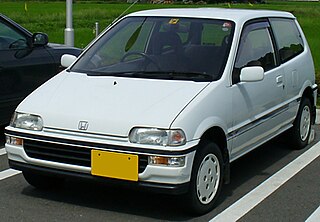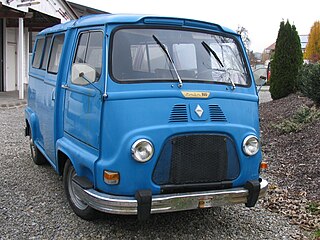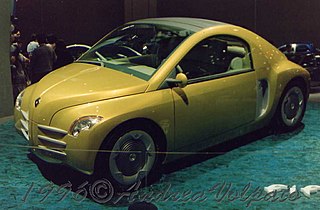
The Volkswagen Type 2 is a forward control light commercial vehicle introduced in 1950 by the German automaker Volkswagen as its second car model. Known officially as the Transporter, Kombi or Microbus, or, informally, as the Volkswagen Station Wagon (US), Bus, Camper (UK) or Bulli (Germany), it was given the factory designation Type 2 as it followed – and was initially derived from – Volkswagen's first model, the Type 1 (Beetle).

The Renault 4, or R4 in short, is an economy car built by the French company Renault from 1961 to 1994. Although the Renault 4 was first marketed as a short estate or wagon, its minimal rear overhang, and its top-hinged, single-piece tail-gate made it the world's first mass-produced hatchback car, as well as the first time Renault had used a front-wheel-drive layout in a family car. A bare-bones, entry-level Renault 3, or R3 was also offered in 1961/1962.
Economy car is a term mostly used in the United States for cars designed for low-cost purchase and operation. Typical economy cars are small, lightweight, and inexpensive to both produce and purchase. Stringent design constraints generally force economy car manufacturers to be inventive. Many innovations in automobile design were originally developed for economy cars, such as the Ford Model T and the Austin Mini.

The Ford Aerostar is a range of vans that was manufactured by Ford from the 1986 to the 1997 model years. The first minivan produced by Ford, the model line was marketed against the Chevrolet Astro/GMC Safari and the first two generations of the Chrysler minivans. Introduced shortly before the Ford Taurus, the Aerostar derived its name from its slope-nosed "one-box" exterior.

Ford Courier is a model nameplate used by Ford since the early 1950s. The Courier moniker has been used on a variety of vehicles all around the world since it was first used in North America for a sedan delivery. The Courier nameplate was also used by Ford for a series of compact pickup trucks and would also see use by Ford of Europe denoting a Fiesta-based panel van. Ford Brazil used the nameplate for a Fiesta-based coupe utility pickup marketed across Latin America.

The Nissan Prairie is an automobile manufactured and marketed by Nissan from 1981 to 2004. Considered a mini MPV or a compact MPV. It was also marketed as the Multi in Canada and the Stanza Wagon in the United States. In Japan, it was exclusive to Nissan Bluebird Store locations, then later at Nissan Blue Stage sales channels. The Prairie had a very flexible seating capability and sliding rear doors on both sides of the vehicle, with a liftgate in the back. The name "prairie" was derived from French which means an extensive area of relatively flat grassland, similar to "steppe" or "savanna".

The Honda Today is a kei car produced by Japanese automaker Honda beginning in 1985. It was replaced by the Honda Life in 1998.

The Citroën C15 is a panel van produced by the French manufacturer Citroën from late 1984 until 2006. It was the successor to the Citroën Acadiane, which had replaced the Citroën 2CV vans that pioneered the box van format from the 1950s to the 1970s, although the Acadiane continued in production alongside the C15 initially. The name refers to the car's 1,500 kg (3,310 lb) French gross vehicle weight rating and indicates its position beneath the C25 and C35 in Citroën's commercial vehicle range at the time.

A panel van, also known as a delivery van, blind van, car-derived van or sedan delivery, is a small cargo vehicle with a passenger car chassis, typically with a single front bench seat and no side windows behind the B-pillar. Panel vans are smaller than panel trucks or cargo vans, both of which use body-on-frame truck chassis.

The Renault Estafette is a light commercial front-wheel drive van, first introduced in 1959 and made by the French automaker Renault between 1959 and 1980, initially using the water-cooled Renault Ventoux engine, then later the Cléon-Fonte engine in a range of body styles. It was replaced by the Renault Trafic.

The Renault 4CV is a car produced by the French company Renault from August 1947 through July 1961. It is a four-door economy car with its engine mounted in the rear and driving the rear wheels. It was the first French car to sell over a million units, and was superseded by the Dauphine.

The Renault Juvaquatre is a small family car / compact car produced by the French manufacturer Renault between 1937 and 1960, although production stopped or slowed to a trickle during the war years. The Juvaquatre was produced as a sedan/saloon until 1948 when the plant switched its full attention to the new Renault 4CV. During the second half of 1952 the plant restarted production of the Juvaquatre sedans/saloons for a period of approximately five months.

The Renault Fiftie was a concept car presented by Renault at the March 1996 Geneva Auto Show to mark the fiftieth anniversary of the launch of the 4CV. The concept used a bright metallic yellow color, honoring the 4CV's "butter pat" nickname.

The Subaru Sambar is a cabover truck and microvan manufactured and marketed by Subaru as Japan's second truck compliant with the country's strict Keitora (軽トラ) or Kei vehicle tax class, after the Kurogane Baby. Introduced in 1961 in microvan and Kei pickup configurations, the Sambar remains in production, now in its eighth generation — beginning with the sixth generation as a rebadged Daihatsu Hijet.

The Citroën Type C was a light car made by the French Citroën car company between 1922 and 1926 with almost 81,000 units being made. Known as Citroën 5HP or 5CV in France and 7.5HP in Britain, it was the second model of automobile designed and marketed by André Citroën, between 1922 and 1926. It followed the 10HP "Type A " (1919), then 10HP "B2" (1921); they were the first European mass-produced cars.

The Isuzu Faster is a pickup truck that was manufactured and marketed by Isuzu between 1972 and 2002 over three generations. It was sold under myriad different nameplates, most commonly they were marketed under their respective model codes: Isuzu KB for the first and second generations, TF for the third. In Japan, the "Faster" name was eventually supplanted by Rodeo. It was also marketed under a number of other brands from the General Motors portfolio. The Faster was succeeded worldwide by Isuzu D-Max, except in Japan and North America.

The Ford Thames 400E is a commercial vehicle that was made by Ford UK and introduced in 1957. Production of the range continued until September 1965, by which time a total of 187,000 had been built. Publicity for the model included hiring the Cy Laurie band to make the promotional film short 'Band Wagon', in 1958, preserved in the 'Ford Film and Video Collection' at the National Motor Museum, Beaulieu

The Renault 1 000 Kg is a light van, initially of a one ton capacity, introduced by the manufacturer in 1947. A 1,400 Kg version followed in 1949, and the Renault 1,400 Kg soon became the more popular choice. A name change in 1959 saw the vans branded as the Renault Voltigeur and the Renault Goélette, but in retrospect the Renault 1,000 Kg name is frequently preferred.
Pichon-Parat was a French carrosserie based in the commune of Sens, in the department of Yonne. Established in 1952, it was known for producing custom cabriolet, coupé, estate car, and shooting brake conversions of established models from major automakers, and for building their own distinctive sporting models with completely original bodywork.



















